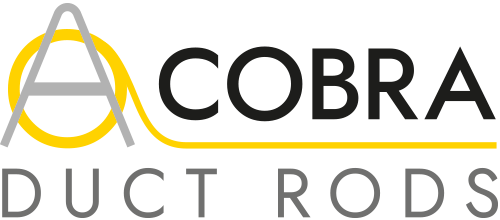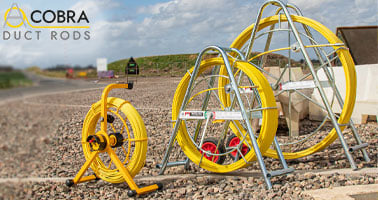How to use a Ritelite Cobra Duct Rodding System
General Safety
There is a risk of personal injury if the user does not follow these instructions when using a Ritelite Cobra Duct Rodding system. These products should only be used by able-bodied, competent adults who have read and understood these instructions. The user is responsible to ensure that all necessary risk assessments have been completed prior to use. Ritelite Cobra Duct Rod’s should never be used if the user is feeling unwell, tired, or is under the influence of drugs and/or alcohol. Ritelite Cobra Duct Rod’s should also be used within the safe systems of work provided by your organisation which may have additional measures other than those listed.
- The recommended PPE for this equipment is goggles and gloves. There may be additional PPE required in your organisations safe system of work.
- This equipment should only be used by trained personnel.
- Inspect equipment before use to check for any damage. If you have any concerns do not use.
- When transporting on vehicles ensure units are secured well.
 Setting Up The Equipment
Setting Up The Equipment
It is recommended that Ritelite Continuous Cobra Duct Rodding Systems are always setup on a firm level surface.
Using The Equipment
Take the Cobra Duct rod to a suitable access point. Ensure you are not operating near critical or live services that could negatively interact with the rodding operation.
When the equipment is likely to be used near a third party, sufficient separation should be provided so that a third party cannot interfere with the equipment. Examples of this would include pavement safety barriers.
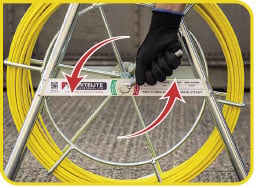
To use release the parking brake by rotating anti-clockwise until the reel can rotate freely in the frame.
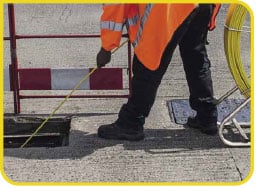
Feed the rod slowly into the conduit by hand, until the guide tip reaches the destination.

If, during the feed-in process a blockage or restriction is met then gently re-try by drawing the rod back a metre and reinserting. Using a stabbing action or forcing the rod could damage existing equipment in the channel. If this fails, try feeding the rod from the other end of the run. Once the rod is at a desired position, re-tighten the parking brake with clockwise rotation so the reel will not rotate in the frame.
WARNING – Never push the equipment beyond its design limits – if you cannot complete the task easily in a reasonable time period you may require different equipment.
Wearing Parts
As part of your equipment check ensure the following wearing parts are in tolerance before use.
Guide Eye
The guide eye will wear at different rates depending on the environment it is used in e.g. wet sand will cause the guide eye to wear faster than dry ducts. You should ensure there is sufficient material in the wearing part of the guide eye to ensure the guide eye can function effectively.

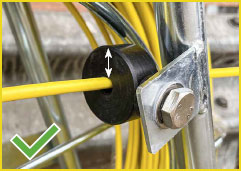
The material should be at least 5-8mm thick.
Rod Condition
Check for thinning of the protective yellow covering and damage to fibreglass core.
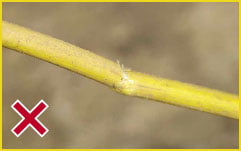

Note: Damaged sections of rod can be repaired using a repair splice. Click here to view the range
![]()
End Fitting
The end fitting should be complete and bonded securely to the end of the rod.

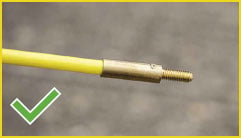
Guide Tip
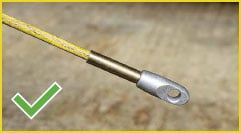 Check the guide tip is secure and in place, and hasn’t worn down too much so that it still has enough strength to pull cables / rope without breaking.
Check the guide tip is secure and in place, and hasn’t worn down too much so that it still has enough strength to pull cables / rope without breaking.
Spare Parts and Accessories
Ritelite supplies a wide range of spare parts and accessories for all Cobra Duct Rodding Systems including guide tips, end fittings, sonde adaptors, repair splice, frames and spare rods.
ACCESSORIES AND SPARES
What makes Ritelite’s Cobra Duct Rodding Systems the best on the market?
With over 30 years manufacturing experience Ritelite makes Cobra Duct Rodding systems that are reliable, high quality and flexible for the many applications that industry professionals use them for. Find out more about what makes our products the best on the market.
What is a Cobra Duct Rod used for?
Cobra duct rods are used in many industries including telecommunications, Electricity and plumbing and Detection when installing cables, pulling draw ropes, surveying drains and ducts and locating blockages. Find out more about the different applications.
